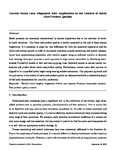Uneven batch data alignment with application to the control of batch end-product quality
| dc.contributor.author | Wan, Jian | |
| dc.contributor.author | Marjanovic, O | |
| dc.contributor.author | Lennox, B | |
| dc.date.accessioned | 2015-10-23T09:22:29Z | |
| dc.date.available | 2015-10-23T09:22:29Z | |
| dc.date.issued | 2014 | |
| dc.identifier.issn | 0019-0578 | |
| dc.identifier.issn | 1879-2022 | |
| dc.identifier.other | 2 | |
| dc.identifier.uri | http://hdl.handle.net/10026.1/3695 | |
| dc.description | keywords: Variable batch lengths keywords: Variable batch lengths keywords: Variable batch lengths keywords: Variable batch lengths keywords: Variable batch lengths | |
| dc.description.abstract |
Batch processes are commonly characterized by uneven trajectories due to the existence of batch-to-batch variations. The batch end-product quality is usually measured at the end of these uneven trajectories. It is necessary to align the time differences for both the measured trajectories and the batch end-product quality in order to implement statistical process monitoring and control schemes. Apart from synchronizing trajectories with variable lengths using an indicator variable or dynamic time warping, this paper proposes a novel approach to align uneven batch data by identifying short-window PCA&PLS models at first and then applying these identified models to extend shorter trajectories and predict future batch end-product quality. Furthermore, uneven batch data can also be aligned to be a specified batch length using moving window estimation. The proposed approach and its application to the control of batch end-product quality are demonstrated with a simulated example of fed-batch fermentation for penicillin production. | |
| dc.format.extent | 584 - 590-584 - 590 | |
| dc.format.medium | Print-Electronic | |
| dc.language | en | |
| dc.language.iso | en | |
| dc.publisher | Elsevier BV | |
| dc.subject | Variable batch lengths | |
| dc.subject | Alignment | |
| dc.subject | Partial least squares | |
| dc.subject | Principal component analysis | |
| dc.subject | End-product quality control | |
| dc.title | Uneven batch data alignment with application to the control of batch end-product quality | |
| dc.type | journal-article | |
| dc.type | article | |
| plymouth.author-url | https://www.webofscience.com/api/gateway?GWVersion=2&SrcApp=PARTNER_APP&SrcAuth=LinksAMR&KeyUT=WOS:000333789200044&DestLinkType=FullRecord&DestApp=ALL_WOS&UsrCustomerID=11bb513d99f797142bcfeffcc58ea008 | |
| plymouth.issue | 2 | |
| plymouth.volume | 53 | |
| plymouth.publisher-url | http://www.sciencedirect.com/science/article/pii/S0019057813002309 | |
| plymouth.publication-status | Published | |
| plymouth.journal | ISA Transactions | |
| dc.identifier.doi | 10.1016/j.isatra.2013.12.020 | |
| plymouth.organisational-group | /Plymouth | |
| plymouth.organisational-group | /Plymouth/Faculty of Science and Engineering | |
| plymouth.organisational-group | /Plymouth/Faculty of Science and Engineering/School of Engineering, Computing and Mathematics | |
| plymouth.organisational-group | /Plymouth/Users by role | |
| plymouth.organisational-group | /Plymouth/Users by role/Academics | |
| plymouth.organisational-group | /Plymouth/Users by role/Researchers in ResearchFish submission | |
| dc.publisher.place | United States | |
| dcterms.dateAccepted | 2013-12-19 | |
| dc.identifier.eissn | 1879-2022 | |
| dc.rights.embargoperiod | Not known | |
| rioxxterms.versionofrecord | 10.1016/j.isatra.2013.12.020 | |
| rioxxterms.licenseref.uri | http://www.rioxx.net/licenses/all-rights-reserved | |
| rioxxterms.type | Journal Article/Review |


